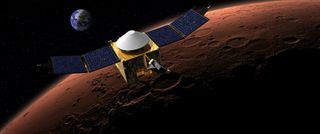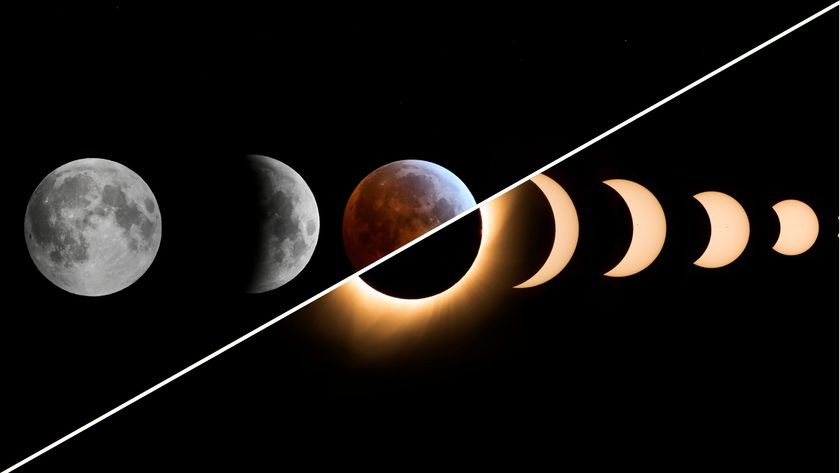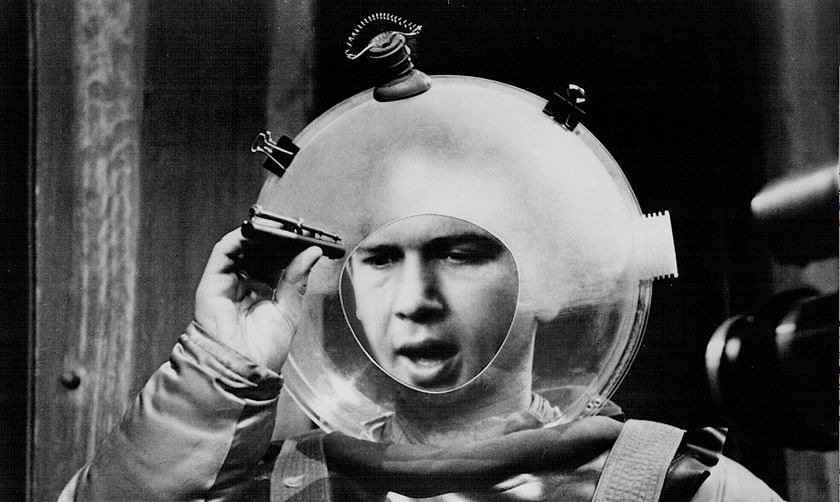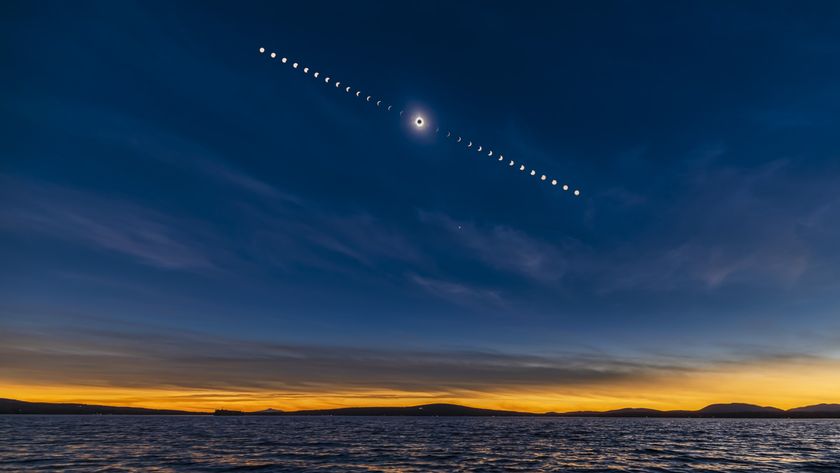MAVEN: NASA's Orbiter Mission to Mars — Mission Details

NASA's Mars Atmosphere and Volatile EvolutioN mission (MAVEN for short) is designed to peer into the Martian past in an attempt to piece together how the ancient Red Planet changed from a wet world into the dry desert scientists study today.
The $671 million mission is investigating the upper atmosphere of the Red Planet, focusing on how the planet lost most of its atmosphere and liquid water.
Spacecraft on and orbiting Mars
MAVEN was selected in September 2008 among 20 mission investigation proposals submitted to NASA in August 2006. The mission was originally part of NASA's Mars Scout program, which aimed to send low-cost (below $485 million) missions to the Red Planet. Although the program was retired in 2010, MAVEN and the 2008 Phoenix lander were successful missions arising from the program.
MAVEN was the 10th Mars orbiter launched by NASA, and it is now one of six active probes currently orbiting the Red Planet: Mars Odyssey was launched in 2001, the European Space Agency's Mars Express launched in 2003, NASA's Mars Reconnaissance Orbiter launched in 2005, and India's $74 million Mars Orbiter Mission blasted off in November 2013, just two weeks before MAVEN. The Indian probe, known as Mangalyaan, arrived in Mars orbit on Sept. 23, 2014. ESA's ExoMars Trace Gas Orbiter arrived after MAVEN, in October 2016.
NASA also has two rovers currently studying Mars from the surface of the planet: Opportunity and Curiosity. The Curiosity rover that landed on the Red Planet in 2012 was the last NASA mission launched to Mars. [NASA's MAVEN Mars Probe: 10 Surprising Facts]
MAVEN instruments
MAVEN carries eight science instruments specifically picked to investigate the Martian atmosphere. [How NASA's MAVEN Mars Orbiter Works (Infographic)]
According to NASA, they include:
- Solar Energetic Particle: This instrument measures the ions of hydrogen and helium emitted by the sun during solar weather, according to NASA. The SEP provides data about how much solar energy is sent to Mars' upper atmosphere and their possible role in "sputtering."
- Solar Wind Ion Analyzer: The SWIA measures the temperature, density and velocity of the solar wind when they come into contact with Mars' atmosphere.
- SupraThermal and Thermal Ion Composition: This instrument examines the composition of high-energy ions in the Martian upper atmosphere. These ions could be lost into space or rebound back into the atmosphere, causing sputtering, according to NASA.
- Langmuir Probe and Waves: This instrument lets scientists find the boundary and density of the ionosphere, potentially allowing them to calculate atmospheric escape, NASA officials said.
- Solar Wind Electron Analyzer: The SWEA measures the angular distributions and energies of electrons. The instrument can help scientists map the solar wind regions as MAVEN orbits the Red Planet.
- Magnetometer: This instrument collects data about the magnetic environment as MAVEN orbits Mars. The magnetometer gives other instruments important information as well, NASA officials said, because magnetic fields can affect the upper atmosphere of the planet.
- Neutral Gas and Ion Mass Spectrometer: This instrument provides data about how the upper atmosphere's composition and structure changes around the planet throughout the mission.
- Imaging UltraViolet Spectrograph: The IUVS examines the chemical makeup of Mars' atmosphere by chemically mapping the upper atmosphere of the planet and measuring the rate of escape for hydrogen atoms.
MAVEN also carries the Electra Communications Relay that will be a backup communications option for Curiosity and Opportunity. MAVEN can serve as a relay point between the Mars rovers and their handlers on Earth. Mars Odyssey and the Mars Reconnaissance Orbiter both serve the same communications functions as well.
Comet Siding Spring
After launch in mid-November 2013, the school bus-size spacecraft embarked upon an approximately 10-month journey to Mars, arriving on Sept. 21, 2014.
MAVEN's arrival happened just a month before the close approach of Comet Siding Spring, which passed about 87,300 miles (140,500 km) from the planet on Oct. 19, 2014. Usually it takes a spacecraft several weeks to calibrate its instruments; in MAVEN's case, scientists interrupted the calibration period to take advantage of the close encounter.
The spacecraft's observations revealed a wealth of results. Material falling off the comet went into the Martian atmosphere, creating a huge meteor shower. The comet's flyby also shed light on the composition of comets from the Oort Cloud, the area beyond Neptune from which Comet Siding Spring came. Scientists detected magnesium, silicon, calcium and potassium in the Martian atmosphere that came from Siding Spring. The comet's magnetic field even blew away a part of the Red Planet's atmosphere into space.
MAVEN subsequently found metal in the Martian atmosphere in 2017, specifically iron, magnesium and sodium ions (electrically charged atoms). While the metal arises from interplanetary dust, it marks the first time this substance was found in an atmosphere outside of Earth's. Notably, metal was first detected in the atmosphere when Comet Siding Spring passed by in 2017. But MAVEN's studies over several years showed the metal was a phenomenon not necessarily related to the comet. The long-term persistence of metal may arise from meteors streaking through the Martian atmosphere.

Atmospheric observations
In November 2015, MAVEN observations confirmed that most of the Martian atmosphere leaked into space, as opposed to being absorbed in the Red Planet's regolith (soil). While most of the erosion took place early in Mars' history, there is still a slow leak going on today, NASA said at the time.
The bulk of the loss happened about 3.7 billion years ago, early in the solar system's history. This was in part due to the sun, which had stronger solar storms back then, as well as more powerful ultraviolet light emissions. Both factors helped to erode the Martian atmosphere. Mars also lost its magnetic field early in its history; the loss provided little shielding against the sun. Scientists did more detailed modeling of the atmospheric loss in results released in 2017, focusing on argon — a gas that does not react with other elements.
MAVEN discovered a tangled magnetic tail behind the planet, a finding that was announced in 2017. Interactions between Martian magnetic fields and the solar wind (a stream of charged particles emanating from the sun) may also accelerate atmospheric space. That's because the connecting fields may attract electrically charged particles and hurtle them into space.
Also in 2017, newly analyzed data from MAVEN showed that Comet Siding Spring's passage by Mars also made the most intense meteor shower ever recorded. The shower had as many as 108,000 meteors per hour and lasted as long as three hours.
As of mid-2018, MAVEN was observing a huge dust storm enveloping the Red Planet. Science observations are still ongoing as scientists try to learn more about how these massive storms develop. "During this global dust storm, #MAVEN will take the opportunity to make unique observations of #Mars' upper atmosphere and the characteristics of dust particles that extend into the upper reaches of the #Martian atmosphere," the MAVEN Twitter account stated on June 13.
Scientists say that MAVEN's findings will also help us to understand exoplanet atmospheres. Learning about the habitability of Earth-size planets is one of the main goals of exoplanet searches and analyses; watching Mars lose its atmosphere is another thing that scientists can consider when looking at similarly sized worlds in solar systems like ours.
Other science results
Strangely, despite Mars' lack of a global magnetic field, full-sky auroras in ultraviolet and visible light may be possible, according to data from MAVEN first discussed in 2015. Auroras are also visible from Earth, but arise from the interaction between solar particles and the Earth's magnetic field.
MAVEN also has imaged "nightglow," which happens when UV light from the sun breaks down nitrogen and carbon dioxide molecules on the day side of Mars. At night, the atoms combine at lower altitudes, releasing energy as UV light — producing the nightglow.
MAVEN also has observed the Martian moon Phobos in ultraviolet light. Researchers hope to learn whether the moon has organic molecules on its surface, as well as the composition of Phobos. Further, MAVEN shifted its orbit in 2017 to avoid a potential future collision with Phobos.
In 2017, NASA announced that auroras were spotted globally on Mars after an unusually powerful solar storm. (The Curiosity rover, working on the surface, also saw a spike in radiation.) "When a solar storm hits the Martian atmosphere, it can trigger auroras that light up the whole planet in ultraviolet light," Sonal Jain, a member of MAVEN's Imaging Ultraviolet Spectrograph instrument team, said in a statement. "The recent one lit up Mars like a light bulb."
For the latest information on MAVEN, visit:
Additional reporting by Elizabeth Howell, Space.com contributor
Join our Space Forums to keep talking space on the latest missions, night sky and more! And if you have a news tip, correction or comment, let us know at: community@space.com.
Get the Space.com Newsletter
Breaking space news, the latest updates on rocket launches, skywatching events and more!

Miriam Kramer joined Space.com as a Staff Writer in December 2012. Since then, she has floated in weightlessness on a zero-gravity flight, felt the pull of 4-Gs in a trainer aircraft and watched rockets soar into space from Florida and Virginia. She also served as Space.com's lead space entertainment reporter, and enjoys all aspects of space news, astronomy and commercial spaceflight. Miriam has also presented space stories during live interviews with Fox News and other TV and radio outlets. She originally hails from Knoxville, Tennessee where she and her family would take trips to dark spots on the outskirts of town to watch meteor showers every year. She loves to travel and one day hopes to see the northern lights in person. Miriam is currently a space reporter with Axios, writing the Axios Space newsletter. You can follow Miriam on Twitter.












